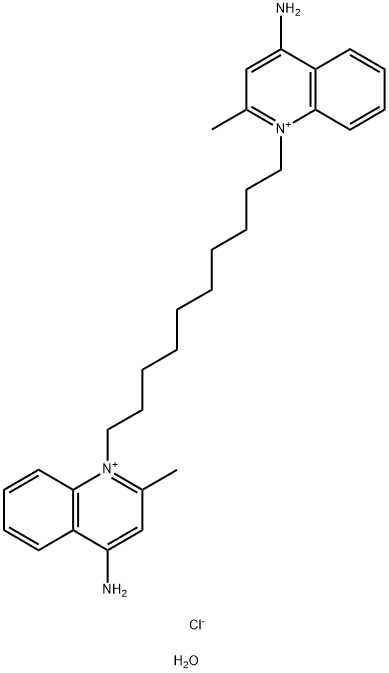氯化异喹铵 水合物

氯化异喹铵 水合物结构式

|
常用名 | 氯化异喹铵 水合物 | 英文名 | Dequalinium chloride hydrate |
|---|---|---|---|---|
| CAS号 | 1255077-34-9 | 分子量 | 510.14 | |
| 密度 | N/A | 沸点 | N/A | |
| 分子式 | C30H42ClN4O+ | 熔点 | ≥300°C (lit.) | |
| MSDS | 中文版 美版 | 闪点 | N/A | |
| 符号 |

GHS07 |
信号词 | Warning |
|
Design and development of novel mitochondrial targeted nanocarriers, DQAsomes for curcumin inhalation.
Mol. Pharm. 11(7) , 2334-45, (2014) Curcumin has potent antioxidant and anti-inflammatory properties but poor absorption following oral administration owing to its low aqueous solubility. Development of novel formulations to improve its in vivo efficacy is therefore challenging. In this study, ... |
|
|
Antimicrobial topical agents used in the vagina.
Curr. Probl. Dermatol. 40 , 36-47, (2011) Vaginally applied antimicrobial agents are widely used in the vagina in women with lower genital tract infections. An 'antimicrobial' is a general term that refers to a group of drugs that are effective against bacteria, fungi, viruses and protozoa. Topical t... |
|
|
XIAP inhibitors induce differentiation and impair clonogenic capacity of acute myeloid leukemia stem cells.
Oncotarget , (2014) Acute myeloid leukemia (AML) is a neoplasia characterized by the rapid expansion of immature myeloid blasts in the bone marrow, and marked by poor prognosis and frequent relapse. As such, new therapeutic approaches are required for remission induction and pre... |
|
|
Dequalinium induces cytotoxicity in human leukemia NB4 cells by downregulation of Raf/MEK/ERK and PI3K/Akt signaling pathways and potentiation of specific inhibitors of these pathways.
Leuk. Res. 38(7) , 795-803, (2014) Delocalized lipophilic cation dequalinium (DQA) selectively accumulates in mitochondria and displays anticancer activity in different malignancies. Our previous studies indicate a DQA-induced cytotoxicity in human acute promyelocytic leukemia NB4 cells by ear... |
|
|
N-palmitoyl-ethanolamine (PEA) induces peripheral antinociceptive effect by ATP-sensitive K+-channel activation.
J. Pharmacol. Sci. 118(2) , 156-60, (2012) Although the antinociceptive effects of N-palmitoyl-ethanolamine (PEA) were first characterized nearly 50 years ago, the identity of the mechanism that mediates these actions has not been elucidated. The present study investigated the contribution of K(+) cha... |
|
|
New method for the quantification of dequalinium cations in pharmaceutical samples by absorption and fluorescence diode array thin-layer chromatography.
J. Chromatogr. A. 1216(25) , 5052-6, (2009) A diode array HPTLC method for dequalinium chloride in pharmaceutical preparations is presented. For separation a Nano TLC silica gel plate (Merck) is used with the mobile phase methanol-7.8% aqueous NH(4)(+)CH(3)COO(-) (17:3, v/v) over a distance of 6 cm. De... |
|
|
Exercise-induced cardioprotection is impaired by anabolic steroid treatment through a redox-dependent mechanism
J. Steroid Biochem. Mol. Biol. 138 , 267-72, (2013) • Supraphysiological DECA treatment on heart redox metabolism was investigated during I/R in sedentary and exercised rats. • DECA reduced SOD and GR activities in exercised rats upon reperfusion. • Reduced antioxidant enzyme activities promote heart thiol oxi... |
|
|
Disintegration of amyloid fibrils of α-synuclein by dequalinium
Biochim. Biophys. Acta 1780(10) , 1156-61, (2008) α-Synuclein is the major amyloidogenic component observed in the Lewy bodies of Parkinson's disease. Amyloid fibrils of α-synuclein prepared in vitro were instantaneously disintegrated by dequalinium (DQ). Double-headed cationic amphipathic structure of DQ wi... |
|
|
Dequalinium induces apoptosis in peripheral blood mononuclear cells isolated from human chronic lymphocytic leukemia.
Invest. New Drugs 29(6) , 1156-63, (2011) B-cell chronic lymphocytic leukemia (B-CLL) is an abnormal neoplasic proliferation of B cells, which accumulate mainly in the bone marrow and blood preventing both B cells development in the lymph nodes and the ability to fight against infection. The antitumo... |
|
|
Characterization of dequalinium as a XIAP antagonist that targets the BIR2 domain.
Apoptosis 16(5) , 460-7, (2011) Inhibitor of apoptosis proteins (IAPs) regulate the activity of caspases in apoptosis. The human X chromosome-encoded IAP (XIAP) is one of the more potent members of the IAP family and it has been described as a central regulator of apoptosis. Thus, molecules... |